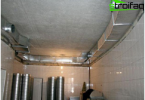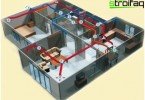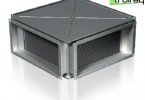How to install and connect a hood in the kitchen
Installing a hood in the kitchen will not only extend the life of wall cabinets, protect furniture, walls, curtain rods and curtains from sticking an unpleasant mixture of grease droplets, soot and dust, but more importantly, the installed device will help clean the air of harmful to the human body combustion products, various fumes and carcinogens. And a master and a novice who has become skilled in repair work and who has decided to install the hood in the kitchen independently, undoubtedly, information about possible difficulties and subtleties of the installation will be useful. Today we will take a closer look at the information on the types of hoods, the features of their design, and also learn how to install a hood in the kitchen, taking into account all safety requirements and observing sanitary standards.
Content
- Methods of operation of exhaust devices
- Types of hoods by installation method
- Basic rules for installing a cooker hood
- We select the required power of the device
Hourly in the kitchen should be at least eight times air exchange (according to the prescribed sanitary standards). Cooker hoods purify the air in the kitchen by removing or filtering it.
Methods of operation of exhaust devices
- Exhaust – a classic version of the hood, in which polluted air is removed from the room out through the ventilation duct.
- Recirculation exhaust devices clean the air of impurities, drive it through the filters and return it back.
- Combined hoods can work both in exhaust and in filtering mode.
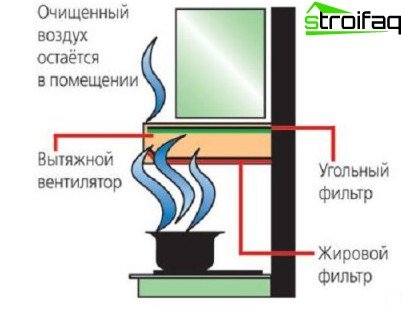
The efficiency of air purification of the recirculation hood directly depends on the condition of the filters; they should be changed every six months
A hood operating exclusively in the filter (recirculation) mode absorbs contaminated air, passes it through a charcoal and grease filter and returns it back already cleaned.
An extractor hood of this design does not remove air from the room, which means that connection to the ventilation shaft is not required. Installation of such a device is quite simple, you only need to securely fix it and connect it to the mains. Take this into account during the repair process (it is necessary to conduct electrical wiring and install a socket in advance to the place of future installation of the hood).
To fasten the device to the wall, it is necessary, first of all, to mark and drill holes with a puncher, then you need to hammer in the plastic dowels and screw the screws into them, on which the device is subsequently hung. Consider installing a hood in the kitchen – a video example will give a clearer picture.
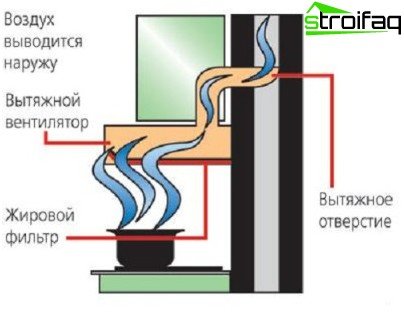
The most effective operation of the device will be with the smallest duct length
Installing a hood capable of removing air from a room requires connecting it with air ducts to the ventilation duct. Consider the distance from the installation site of the hood to the ventilation hole: long ducts will not decorate the interior of the kitchen. Before connecting the hood in the kitchen, consider the appropriateness of the device method: if the stove is located far from the ventilation hole, but close to the outer wall, then one of the options for exhausting the exhaust air can be to connect the air duct to the hole specially made in the main wall. The hood mount for the kitchen is different for each specific model, since there are many technological varieties.
Types of hoods by installation method
- hanging (they are mounted under a hanging cabinet above the stove);
- built-in (they are built directly into the kitchen furniture above the stove);
- wall-mounted (attached to the wall);
- angular (provided for fixing in the corner);
- island (designed for ceiling mounting).
Basic rules for installing a cooker hood
Regardless of the type and model, the hood device in the kitchen should be made in accordance with the general rules and regulations, to ensure the safe and most productive operation of the device. First of all, make sure that the installation height of the hood from the electric hob is within 70–80 cm, and from the gas stove 80–85 cm. A smaller distance will lead to excessive heating and can cause damage to the hood, and, most importantly, In this case, a fire is likely. More than normal distance reduces the efficiency of the device. To be effective hood for the kitchen, its dimensions must also comply with the necessary standards. Typically, the width of the hob surfaces is standard (50 or 60 cm).
The efficiency of the hood largely depends on the design of the duct: it is necessary to ensure unhindered passage of the air flow, minimizing the length of the duct and the number of turns to a minimum. Smooth-wall ducts are most effective. Corrugated ducts easily bend at the right angle, but the ribbed surface creates some interference with the air. If the kitchen is installed gas water heater for heating water, in no case should you connect the duct from the hood to the smoke channel of the column. A working hood can provoke the exit of combustion products from the column into the kitchen, which is extremely dangerous for the life of households!
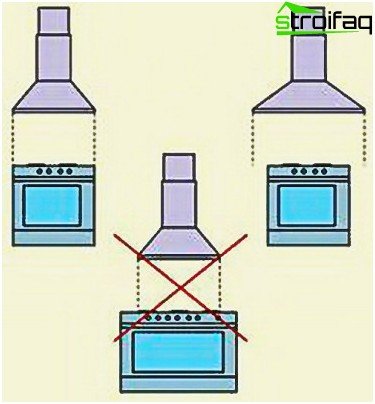
The width of the hood should correspond to the width of the hob (or be slightly wider, for more efficient absorption)
We select the required power of the device
The choice of the type of hood depends on the preferences of the owner and the distance from the location of the outlet of the exhaust ventilation duct to the stove. Pay attention to the size of the outlet diameter of the adapter between the duct and the hood: the larger the diameter, the less energy is needed for the effective operation of the device. When choosing a hood, pay attention to its performance. Do not strive to buy the most powerful device of all possible.
The hood should be selected for the diameter of the exhaust duct, since its efficiency depends not so much on the fan power as on the diameter of the ventilation duct. It is not difficult to understand how the hood in the kitchen works if the diameter of the ventilation shaft does not correspond to an overly powerful exhaust fan: it is obvious that the appliance will consume a lot of electricity at a very low efficiency. Figuratively speaking, the hood will work at full power, “choking” from the efforts. In any case, it will not be possible to push a large volume of air through a narrow channel. Practice shows that the greatest performance is achieved when working at low and medium fan speeds.
As you can see, a hood for a kitchen with your own hands may well be installed. Be sure to consider the safety rules when connecting and think over the most profitable version of the device. We hope that the above information on how to make a hood in the kitchen will be informative and useful for you.


